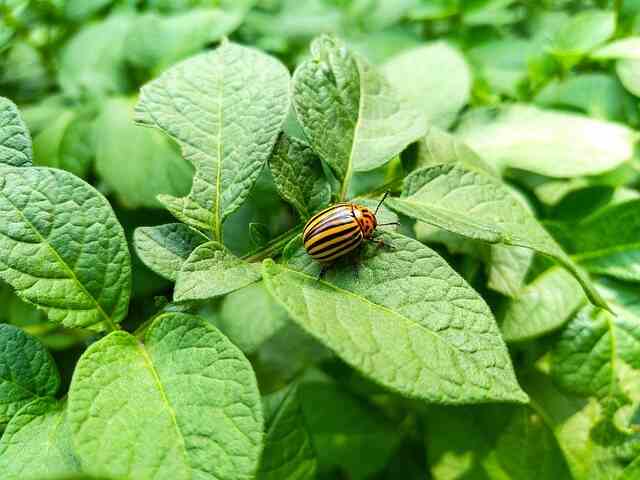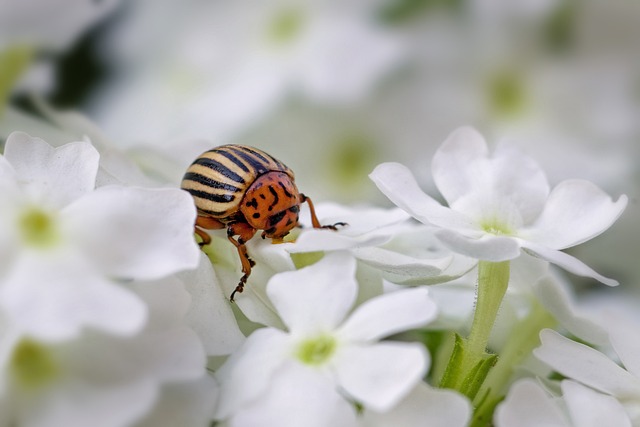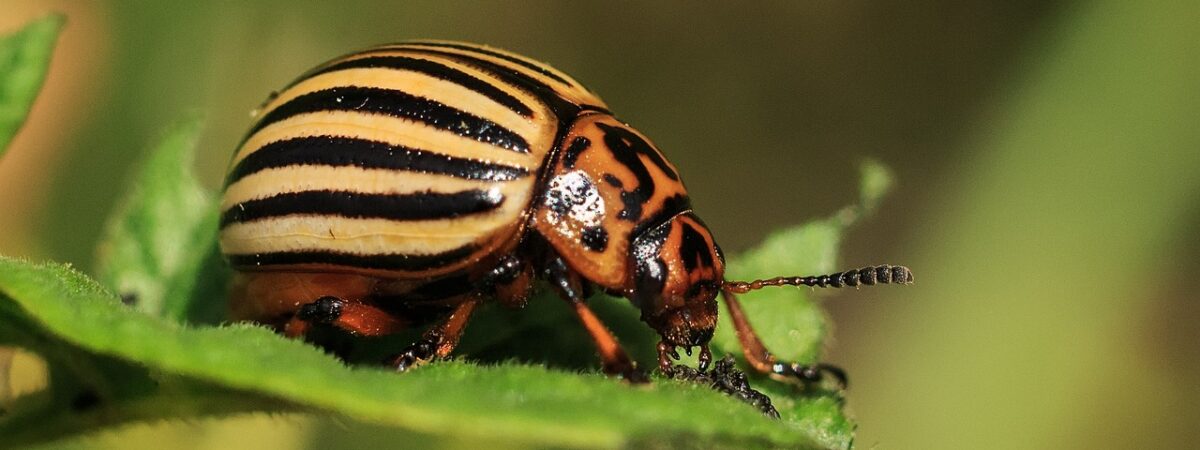Are you tired of watching your potato plants get devoured by pesky Colorado Potato Beetles?
Don’t let these tiny bugs ruin your garden harvest!
With a few simple strategies and diligence, you can keep Colorado Potato Beetles under control and protect your crops.
In this post, we’ll share some tips and tricks to help you prevent these destructive pests from taking over your garden. From natural methods to chemical solutions, we’ve got you covered. So, let’s dig in and get ready to banish those beetles for good!
What is Colorado Potato Beetles?

Colorado Potato Beetles (Leptinotarsa decemlineata) are small, oval-shaped insects that measure about 10 mm in length. They have distinctive yellow-orange bodies with ten bold black stripes on their wing covers. Their heads are also black with two white stripes on either side.
The life cycle of Colorado Potato Beetles consists of four stages: egg, larva, pupa, and adult. In early spring, adults emerge from overwintering sites and begin feeding on plant leaves. Females then lay clusters of bright orange-yellow eggs on the undersides of leaves. These eggs hatch into larvae after about a week.
The larvae of these are plump, soft-bodied, and have a reddish-brown head. They have a distinctive appearance, with two rows of black dots along their sides and a black patch on their tails. The larvae feed voraciously on potato leaves and can cause significant damage to plants.
After several weeks of feeding, the larvae enter the pupal stage. During this stage, they develop into adult beetles within a cocoon-like structure. The adult beetles emerge from the pupae and begin feeding and reproducing. They can produce up to two generations per year, and the entire life cycle takes about 30 to 40 days to complete, depending on temperature and other environmental factors.
Impact of Colorado Potato Beetles on gardens
Colorado Potato Beetles can have a significant impact on a garden, especially if left unchecked. These pests are voracious feeders and can quickly defoliate potato plants, causing significant damage and reducing crop yields.
The larvae of these insects are especially damaging as they can consume entire leaves and stems, leaving plants weakened and vulnerable to other pests and diseases. In severe infestations, the defoliation caused by these pests can also reduce the quality and quantity of potato tubers produced by the plant.
Additionally, they can develop resistance to certain insecticides, making them challenging to control with chemical treatments. This can lead to increased use of pesticides and other harmful chemicals in the garden, which can have negative impacts on beneficial insects, soil health, and the environment.
Overall, it’s essential to take preventative measures to keep Colorado Potato Beetles under control in the garden to protect crops and minimize damage
Plant hosts of Colorado Potato Beetles

Colorado Potato Beetles are primarily known for their devastating impact on potato plants, which are their preferred host. However, these pests can also feed on other plants in the Solanaceae family, which includes tomatoes, eggplants, peppers, and petunias.
In addition to Solanaceae plants, they may also feed on plants in other families, such as nightshades and bindweeds. However, they prefer to feed on plants with similar characteristics to potatoes, such as those with large, succulent leaves.
It’s worth noting that while they may feed on other plants, they typically prefer potatoes above all else. This is because potatoes provide an ideal environment for the beetles to feed and reproduce, with plenty of foliage and tubers to sustain them.
If you have a garden with potatoes, tomatoes, eggplants, peppers, or other Solanaceae plants, it’s essential to be vigilant for signs of Colorado Potato Beetle infestation. Taking preventative measures to keep these pests under control can help protect your plants and ensure a bountiful harvest.
Signs of Colorado Potato Beetle infestation
here are some signs of Colorado Potato Beetle infestation:
Defoliation: One of the most noticeable signs of Colorado Potato Beetle infestation is defoliation of potato plants. These pests feed voraciously on plant leaves, often starting with the lower leaves and working their way up. This can cause significant damage and may eventually kill the plant.
Larvae: The larvae are plump, reddish-brown caterpillar-like insects with two rows of black dots along their sides and a black patch on their tails. These larvae can be seen crawling on plant leaves, and heavy infestations may result in entire plants covered in larvae.
Adult beetles: Beetles are also easy to identify as adults. These beetles have distinctive yellow-orange bodies with ten bold black stripes on their wing covers. They can often be seen feeding on plant leaves and may also fly away when disturbed.
Eggs: Female Colorado Potato Beetles lay clusters of bright orange-yellow eggs on the undersides of leaves. These eggs are small and oval-shaped and may be found in groups of 10-30.
Plant damage: Colorado Potato Beetle feeding can cause a distinctive pattern of damage on potato plant leaves, with irregular holes and patches of missing tissue. The damage caused by these pests can reduce plant vigor, yield, and overall health.
If you notice any of these signs of these Beetle infestation, it’s essential to take action quickly to prevent further damage to your plants. There are several strategies for controlling these pests, including cultural practices, natural remedies, and chemical treatments
How to prevent Colorado Potato Beetles in Your Garden?

Cultural control methods
Cultural control methods are an effective way to prevent and manage Colorado Potato Beetles in the garden. These methods involve changing the environment or practices in the garden to discourage or reduce pest populations. Here are some cultural control methods for preventing Colorado Potato Beetles in the garden:
Crop rotation
Colorado Potato Beetles overwinter in soil and debris, so rotating crops can help reduce their population by disrupting their life cycle. Avoid planting potatoes or other Solanaceae plants in the same area for at least three years.
Timely planting
Early planting of potatoes can help avoid peak Colorado Potato Beetle populations, which typically occur in mid- to late summer. Planting potatoes in late spring can also help reduce pest populations by allowing the plants to mature before the beetles become active.
Sanitation
Removing and destroying potato plant debris, including leaves, stems, and tubers, can help reduce overwintering populations of Colorado Potato Beetles. This also helps prevent the spread of diseases and other pests in the garden.
Handpicking
Colorado Potato Beetles can be removed from plants by handpicking, particularly in small gardens or for home gardeners. Wear gloves and remove both larvae and adults, placing them in a bucket of soapy water to drown them.
Mulching
Applying a layer of organic mulch around potato plants can help discourage Colorado Potato Beetles from laying eggs on the plants. This also helps conserve moisture and suppress weed growth.
By incorporating these cultural control methods into your gardening practices, you can reduce Colorado Potato Beetle populations and protect your potato plants from damage. Combining cultural methods with natural and chemical treatments can provide an integrated approach to pest management in the garden.
Mechanical control methods
Mechanical control methods are another effective way to prevent and manage Colorado Potato Beetles in the garden. These methods involve physically removing or trapping the pests to reduce their population. Here are some mechanical control methods for preventing Colorado Potato Beetles in the garden:
Row covers
Using row covers to cover potato plants can help prevent Colorado Potato Beetles from accessing the plants. This physical barrier can be especially effective in the early stages of the season when beetles are just emerging.
Vacuuming
Using a handheld vacuum to suck up Colorado Potato Beetles and their eggs can be an effective method of controlling their population. This method can be especially useful for small gardens or potted plants.
Sticky traps
Placing sticky traps around potato plants can help trap adult Colorado Potato Beetles. These traps can be purchased or made from yellow cardboard coated with petroleum jelly.
Beetle barriers
Placing sticky barriers around the base of potato plants can help prevent Colorado Potato Beetles from crawling up the stems to feed on the leaves. These barriers can be made from sticky tape or petroleum jelly applied to a strip of cardboard.
High-pressure water sprays
Spraying potato plants with a high-pressure water sprayer can help dislodge and remove Colorado Potato Beetles from the leaves. This method can be effective in small gardens or for individual plants.
By incorporating these mechanical control methods into your gardening practices, you can reduce Colorado Potato Beetle populations and protect your potato plants from damage. Combining mechanical methods with cultural, natural, and chemical treatments can provide an integrated approach to pest management in the garden
Chemical control methods
Chemical control methods are also available for preventing and managing Colorado Potato Beetles in the garden. However, it is important to use these methods with caution and follow label instructions carefully to ensure safe and effective use. Here are some chemical control methods for preventing Colorado Potato Beetles in the garden:
Insecticides
Insecticides can be effective in controlling Colorado Potato Beetles. These chemicals are typically applied to the plant foliage and can kill both adult beetles and larvae. Common insecticides for Colorado Potato Beetles include carbaryl, imidacloprid, and spinosad. It is important to follow the instructions on the label carefully, including application rates and timing.
Systemic insecticides
Systemic insecticides can be applied to the soil or plant roots and absorbed into the plant tissue, providing longer-lasting control of Colorado Potato Beetles. These chemicals are effective against both adult beetles and larvae. Common systemic insecticides for Colorado Potato Beetles include imidacloprid and thiamethoxam.
Biological control
Biological control methods involve the use of natural predators or parasites to control pest populations. The use of predator insects such as lady beetles or parasitic wasps can be effective in reducing Colorado Potato Beetle populations. However, this method can take longer to see results and may not be as effective as chemical methods.
It is important to note that chemical control methods should be used as a last resort and only after cultural and mechanical methods have been tried. Additionally, it is important to always follow label instructions carefully and take appropriate safety precautions when handling and applying chemicals in the garden
Additional Tips for Preventing Colorado Potato Beetles

Here are some additional tips to prevent and manage Colorado Potato Beetles in the garden:
Crop rotation
Colorado Potato Beetles can overwinter in soil and plant debris, so rotating crops can help break their lifecycle and reduce their population. Avoid planting potatoes or other nightshade family plants in the same area for at least two years.
Timely planting
Planting potatoes early in the season can help avoid peak Colorado Potato Beetle activity, which usually occurs in mid-to-late summer.
Hand-picking
Regularly inspecting potato plants and hand-picking any Colorado Potato Beetles or their eggs can be an effective way to control their population, especially in small gardens.
Mulching
Mulching can help prevent Colorado Potato Beetles from laying their eggs in the soil. A layer of straw or other organic mulch around potato plants can make it harder for beetles to find suitable egg-laying sites.
Healthy plants
Maintaining healthy potato plants with proper fertilization, irrigation, and pruning can help reduce their susceptibility to Colorado Potato Beetle damage.
By incorporating these additional tips into your gardening practices, you can help prevent and manage Colorado Potato Beetles in your garden. Remember, a combination of cultural, mechanical, natural, and chemical methods can provide an integrated approach to pest management and help keep your potato plants healthy and productive
Conclusion
Preventing and managing Colorado Potato Beetles in the garden requires a combination of cultural, mechanical, natural, and chemical control methods. By using a holistic approach, gardeners can reduce the population of these destructive pests and protect their potato plants from damage.
It is important to monitor your potato plants regularly for signs of infestation and take action promptly to prevent the spread of the beetles. With a little effort and attention, you can successfully prevent Colorado Potato Beetles in your garden and enjoy a healthy and bountiful harvest of potatoes.
You may also like read
How to get rid of spider mites? – Identification and control measures






